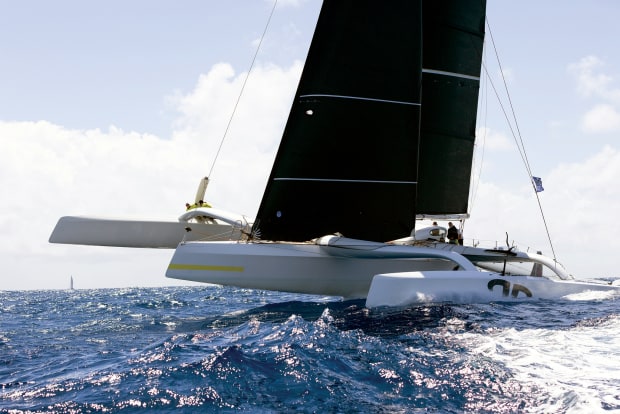
Photo courtesy of RORC/Arthur David
Brian Thompson could have become just another financial type on Wall Street, which would have been surprising enough in itself for a Brit who grew up in the London suburbs, reading Science Fiction books on smoke-filled commuter trains. From an early age, though, Thomson wanted something rarer still. He also displayed a sense of purpose that years later resulted in his becoming one of the world’s great offshore sailors, with four circumnavigations and over 40 world sailing records to his credit.
“For our summer holiday we took our caravan to West Mersea on the North Sea,” says the deceptively soft-spoken Thompson, hardly the type you’d expect to be one of the toughest sailors around. “It was a real Mecca of sailing at the time, full of well-known sailors, I pottered around in Cadets and Mirrors. When I was 12, just me and the family dog went up the River Crouch, a real Swallows and Amazons adventure. I remember sailing back, in foul tide and little wind, it was after 10 at night by the time I got back, but my parents didn’t appear to be bothered. Those were my first singlehanded experiences.”
In 1973, Thompson was accepted to one of the top free schools in the UK, the Latymer School in West London, which had 100 places for 1,000 applicants. During the two-hour commute to and from class, Thompson, in addition to doing a lot of passive smoking thanks to his fellow commuters, did a lot of reading.
“I read sailing magazines from cover to cover, especially Bob Fisher’s column. I read about Sir Francis Chichester, Bernard Moitessier, Robin Knox-Johnston, Rodney Patterson, Paul Elvstrøm, Peter Blake and Eric Tabarly. I guess what fascinated me the most was their consistent success on the world stage. They were the best sailors of their generation. You always expected them to win. It was also about their all-round design and sailing knowledge. I must have read four books a week, including science fiction and classic literature. As I got older, I read more philosophical books. I got seriously lost in reading.”

Photo courtesy of RORC/Ted Martin
In 1976, the Thompson family moved near Gatwick Airport, and Thompson began sailing on the South Coast of the UK in his family’s 28ft Spinner cruiser. “We did a little bit of racing. I remember doing the Round the Island Race (Isle of Wight), but even going cruising, in my head I was racing every other boat around us. I was trimming and steering the boat as efficiently as possible.”
After graduating from Warwick University, where he also did some intercollegiate sailing, Thompson bought a Honda XL500, which he still owns, and set out to explore Europe and North Africa. It was around this same time, as a result of an otherwise random conversation, that he started working on big boats as well. “I was chatting with a Swan 48 skipper in Palma Majorca,” he says. “It opened my eyes to the idea that you could make a living out of sailing. After that I was walking the docks, looking for day-work,”
Eventually, Thompson got a job on the famous Bob Miller designed 75ft Maxi Mistress Quickly, which in turn opened the door to other racing opportunities. These included the J Class Velsheda, the 80ft Camper & Nicholson Lord Jim, the 215ft Classic three-masted schooner Le Créole and the America’s Cup Classic Sceptre.
“On Mistress Quickly I got to learn a whole different level of performance, and a hell of a lot about how to sail bigger boats,” he says. “At the same time, I was reading about the latest yacht designs. In those days no one was paid to do the America’s Cup or the Whitbread, it was all young guys that did it for the love of it. To get paid you had to be on superyachts, and there were only about 50 in the world, compared to the thousands that there are now.”
In 1985, Thompson sailed with his recently retired parents on their Oyster 39 across the Atlantic to Antigua, taking 21 days in all, an experience that would also serve to take his sailing career to the next level, as it were. “It was my first Atlantic crossing and the farthest I had ever sailed. I was fascinated by astronavigation and being out on the ocean.”
Still just 22, he now found himself in the Caribbean. Soon afterward, while in Antigua, he got a job running a catamaran and began doing deliveries across the Atlantic. “I did the Fastnet Race on a Swan 48,” he says, “and when the skipper, Steve Cross, retired, I became the skipper at just 23. Besides charters, we did a lot of racing. We won our class in the Newport Bermuda Race and the Pineapple Cup overall. I really enjoyed that time, but I didn’t want to be a charter skipper taking people on holiday. I looked at using my economics degree to do a job in finance. I was in America a lot, and Wall Street was tempting.”
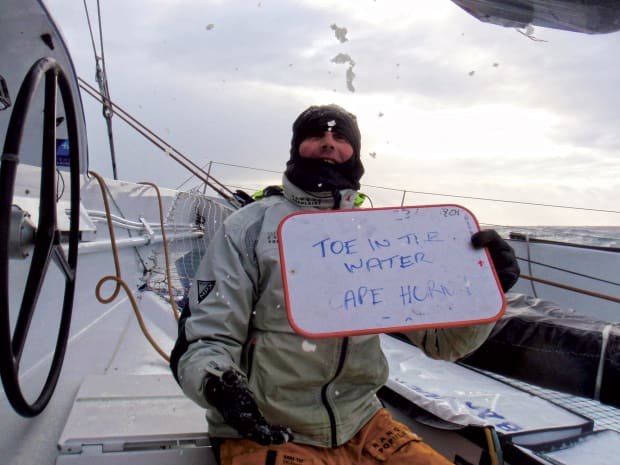
Photo courtesy of BPCE
It was then, though, in 1988, that Thompson was in Newport, Rhode Island, running a Swan 59, when a 60ft trimaran arrived at the same dock. It was Philippe Poupon’s Fleury Michon, which had just smashed the OSTAR record, completing the race in 10 days, 9 hours and 15 minutes.
“Suddenly the dock was full of French journalists,” Thompson says, “and although I didn’t know it then, it changed my life. I had only raced monohulls before, I was blown away by the speed with which Fleury Michon had been raced solo by Poupon across the Atlantic. I had never managed to go that fast for 24 hours, let alone 10 days. Multihulls were then perceived as funny boats, I remember doing the Round the Island Race as a kid, and a trimaran overtook us. It was a spindly looking thing, flying past us, and my dad said, ‘That isn’t really a boat.’ That was the view—crazy, dangerous boats.”
Now, though, the scales having “dropped from his eyes,” Thompson began looking for a way to enter the world of multihull racing. Not surprisingly, an ORMA 60 like Fleury Michon, was way too expensive, so Thompson looked around for other sailors’ multihulls to sail on. He also kept an eye out for a more affordable boat of his own to purchase, and after U.S. sailor Rich Wilson had recently won his class in the 1988 OSTAR aboard his Dick Newick trimaran, Curtana, Thompson bought it.
“I had put away a bit of money, and it was a beautiful boat, a 35ft trimaran and really fast, with a big wing mast and no engine,” Thompson says. “The boat was up in Maine at Walter and Joan Greene’s Boatyard. I went up to see it in the snow and bought it straight away. In the spring, I launched it with Walter and Joan. Mike Birch [who had won the first Route du Rhum in 1978] was also there. Mike had his boat Olympus built at Greene’s. I got a lot of help from them, which was great.”
“The acceleration was amazing,” he adds, “much more than I was used to. I was sailing faster than I ever had, upwind at 12 knots and downwind 17. The self-steering was basic to say the least. You couldn’t sleep for more than 10 minutes at a time. I felt a great deal of trepidation like I was stepping into another galaxy, far, far away. The boat was very fragile, the hulls were strong, made from cold-molded wood, but the beams were made of plywood, nothing like the carbon-fiber of nowadays. You always had to be aware of not breaking the boat. The fastest I ever went was on bare poles, doing 20 knots in an Atlantic storm, which was very scary!”
Thompson’s first race aboard the boat, which he rechristened Transient, was in the 1990 TwoSTAR Race with fellow veteran offshore sailor Helena Darvelid. A beam broke halfway across the Atlantic, and with no engine, it took 13 days to nurse the boat back to shore. In the 1992 OSTAR, however, Thompson and Helena won Class 5, in the process setting a class record that stands to this day.
“The [race] finished in Newport, the same place I first saw my first ORMA 60, so I have a real affinity with the town. I sold the boat that summer, it took up a lot of time, I didn’t have much sponsorship, and I was paying for it myself. After that I met Dick Skipworth who had a Rolfsen & Morrison 36ft trimaran called Severalles Challenge, and I borrowed it to do the 1993 Round Britain Race with Helena. It could do 26 knots, making it the first high-performance multi I had raced that you could push hard without it breaking. We won our class and came second overall to Steve Fossett and Dave Skully racing Lakota,” Thompson says—Lakota being the 1990 VPLP ORMA 60 aboard which Fosset had recently won the 1990 Route du Rhum. Soon afterward, Fossett and Skully invited Thompson to join them, after which Lakota did the Fastnet racecourse, starting just after the monohulls, as multihulls were not yet allowed to enter.
“By the time we got to The Needles (11 miles into the Race), we had overtaken the whole fleet, and we set the world record for the Fastnet course. I joined Lakota at a good time. Multihulls were just being allowed into the Transpac, the Bermuda Race, San Francisco Yokohama, and the Los Angeles Honolulu,” Thompson says. “Lakota she was really well-built and all-carbon. We sailed from as far afield as the North of Scotland to Japan. I became very comfortable with sailing trimarans.”

Photo courtesy of KOS Picture source/kospictures.com
In 1998, Cookson Boatworks in Auckland, New Zealand, started building the Morrelli & Melvin designed PlayStation for Fossett, which Fossett planned to enter in a round-the-world race dubbed “The Race,” due to start from Barcelona, Spain, on December 31, 2000. Originally launched with an LOA of 105ft, PlayStation was made from pre-preg carbon with an aluminum honeycomb core. In this configuration, she promptly set a new 24-hour world speed record. A short while later, in the run-up to The Race, PlayStation was lengthened to 125ft. However, her max beam remained at 60ft. Unfortunately, the boat hit an unidentified floating object, or UFO, off Brazil on Day 16 of the race itself, breaking a daggerboard and forcing the boat drop out. Undeterred, in 2001, PlayStation with Thompson on board, went on to cross the Atlantic in 4 days and 17 hours, a new world record. Then, in 2004, now renamed Cheyenne and with Thompson once again aboard, the boat set a new round-the-world record of 58 days, 9 hours, 32 minutes, 45 seconds.
“We could have completed The Race, but we wouldn’t have won,” Thompson says. “Even for the 2004 world record, we broke the forestay, but managed to repair it. The loads were huge on PlayStation. You still had to have a lot of seamanship. You couldn’t go flat out all the time, especially in the boat’s first iteration…60 percent of the time you had to back off, if the front beam was submerged, you could easily pitch-pole.”
This is not to say PlayStation was the only big multihull of its era facing these kinds of challenges. In fact, from about 2002 on, racing multihulls as a group found themselves on the receiving end of a whole lot of bad press, especially following the 2002 Route du Rhum, in which no fewer than 15 ORMA 60s ended up retiring, six of them due to capsizes, no less.
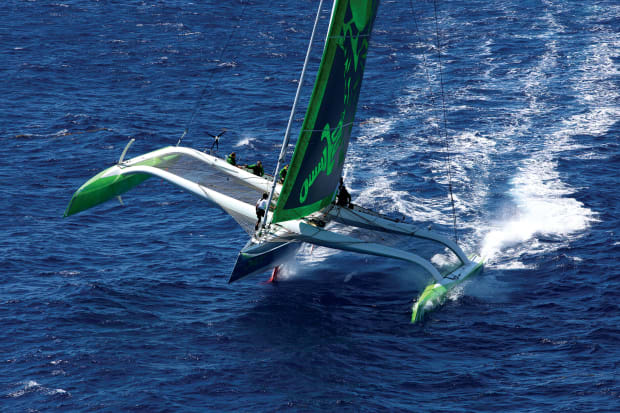
Photo courtesy of RORC/Tim Wright
“The 2002 Route du Rhum was a disaster with ORMA 60s breaking up left, right and center. Out of that, though, came the MOD 70s,” Thompson says. “Steve Ravussin came up with the idea of an offshore ORMA-type boat. He got together with the Groupama Team and VPLP to create a design that was faster than an ORMA, but stronger, and where you didn’t have to slow down for sea state. The ORMAs had broken so much, they knew where the weak points were, and they eventually made boats that were nearly indestructible.”
Meanwhile, although it would be a few years before Thompson was to race a MOD 70, his career was continuing to forge ahead as he found himself breaking into the French sailing fraternity, racing two seasons aboard the ORMA 60 Sergio Tacchini, a Nigel, and winning the 2004 Quebec St. Malo Race.
“It was amazing, we were up against Franc Cammas and Michel Desjoyeux, in the heyday of ORMA, so beating them was a great achievement. With PlayStation and Lakota, we were always on our own, racing against the clock. After eight days in Quebec St. Malo, we were only 10 minutes ahead of Cammas and Desjoyeux, so it was a big, big win. Also, we were sailing for the first time with foils, trim tabs and a canting rig.”
After that, in 2005, Thompson skippered the maxi catamaran Doha 2006 to victory in the Oryx Quest round-the-world race, which was followed his participation in the Volvo Ocean Race. The latter was in many ways due to the fact that the hi-tech monohulls of the time were now being designed with canting keels and starting to display various multihull characteristics as a result. This led Thompson to join the Volvo 70 ABN AMRO ONE for the boat’s Southern Ocean leg. Skippered by Mike Sanderson, the team would go on to win the 2005-06 Volvo Ocean Race.
“ABN had a top crew, and a lot of them had been involved in the design stage for this new canting-keel monohull. One of the big design wins by Juan Kouyoumdjian was the twin-rudder,” he says. “At the time, it was seen as a ‘French multihull thing’ and not popular with monohull design. However, it was one of the big advantages for ABN, because they could heel the boat over, reducing the wetted surface and still steer, even in rough conditions.”
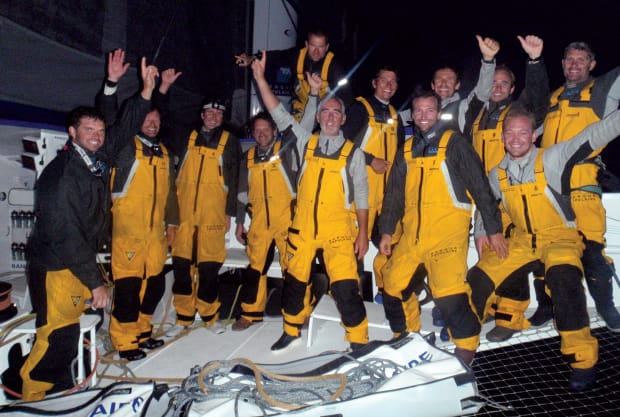
Photo courtesy of BPCE
In 2008, Thompson went on to complete his third circumnavigation, and his first solo lap, campaigning the new Juan Kouyoumdjian designed IMOCA 60 Pindar. In the end, though, despite the fact Thompson managed to finish fifth in the 2009 Vendée Globe, it was a tough experience. “The bow broke, the hydraulics, the wind instruments, the engine… I got stuck up the rig for an hour in 40 knots…it was a real battle to finish.”
By then, though, the new MOD 70 Class concept was also off and running, with a number of the 70ft trimarans in build. In 2011, seven teams were racing, with the list of skippers including such legends as Michel Desjoyeaux, Roland Jourdain, Yann Guichard and Jean-Pierre Dick. Thompson was also in the mix, sailing with Sidney Gavignet aboard the MOD 70 Oman Sail as part of the class’s debut season. After that, in 2012, Thompson was the only non-French crew on Loick Peyron’s 130ft VPLP trimaran Banque Populaire V when it set a new Jules Verne Record of 45 days, 13 hours and 43 minutes.
In 2015, American owner Lloyd Thornburg bought Desjoyeux’s MOD 70, renaming her Phaedo3 and installed Thompson as skipper. Phaedo3 smashed the race record for the RORC Caribbean 600 and beat its own record the following year. Phaedo3 went on to take the world records for the Los Angeles to Honolulu, Around Isle of Wight UK, Antigua to Newport, Round Ireland and RORC Transatlantic races.
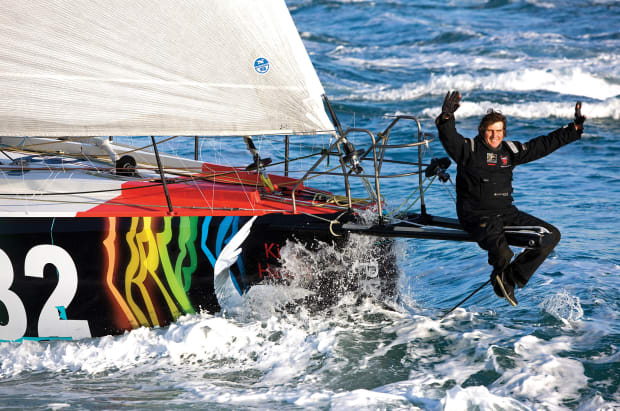
Photo courtesy of KOS Picture Source/kospictures.com
“I think Lloyd Thornburg was the first private owner of an MOD 70 and Phaedo3 was a really open project,” Thompson says. “We worked together on a schedule of races and record attempts with a plan to do as much racing as possible. We covered an amazing number of miles with Phaedo3—the Caribbean, Europe, both the East and West Coasts of the United States and Hawaii. To put the Phaedo3 team together was a process of choosing people I had sailed with before or those who had the right skills by reputation. It was quite a young squad with a lot of talent, and they needed to be all-rounders. I look for team players, not big egos, people who want success together and not just for themselves. You need people that you want to spend time with, so it was also a very fun team.”
In 2019, Thompson joined Jason Carroll’s team from Larchmont, New York, racing the MOD 70 Argo. During training, 48-hours before the start of the RORC Caribbean 600, Argo capsized at full speed. The boat miraculously made the start line, after which it went on to engage in a no-holds-barred match race with Giovanni Soldini’s Maserati, ultimately losing out by just 7 minutes. There was more heartache for Argo in the 2020 RORC Caribbean 600, when the boat lost out to Peter Cunningham’s MOD 70 PowerPlay by a mere 4 minutes after another epic match-race. Finally, in 2022, Argo won the RORC Caribbean 600 on its third attempt, setting a new race record in the process.
“The capsize with Argo was not my first experience with this kind of thing. We nearly capsized Phaedo3 in a similar way. On Phaedo3 we got to about 70 degrees, and it came back up again. But with Argo we carried on going, which was an ‘Oh shucks moment.’ The stuffing in of the bow happens quickly, and then [the boat] just slowly lifts up more and more. Then it turns into the wind and when you get to 90 degrees it gets quite concerning. Very luckily, the mast did not break, so we stayed at 90 degrees for some time, allowing the crew to lower themselves into the water, or get themselves inside the boat, which is where you want to be. It was daylight and we were only a few miles from Dickinson Bay Antigua. The yachting community in Antigua were fantastic. We had a dive team and a rescue boat out straight away. Five hours after the capsize, we were back in Falmouth Harbour with the community offering to help get us back in the RORC Caribbean 600.”
Beyond that, 2021 and 2022 have been very successful years for Argo in a number of other events as well, with a victory in the Rolex Middle Sea Race and a pair of new world records: the Bermuda to Plymouth, UK, Record of 4 days, 19 hours, 29 minutes; and the Antigua to Newport Record of 3 days, 16 minutes. Adding to the interest, the MOD 70s racing today are no longer one-designs, but largely custom designs with teams like Maserati, PowerPlay and Argo all developing various different foil and rudder systems in a never-ending quest for more speed.
“The development process on Argo has been very interesting,” Thompson says. “We have been through two sets of foils and three sets of rudders. The T-Foil rudders have definitely helped to reduce drag by getting the leeward hull out of the water. But because the MOD 70 was not originally designed as a foiling boat, the speed differential is not as big as you might expect. Maserati is the most modified, and each year, Maserati is getting faster and faster. PowerPlay does not have T-foils, but can be quicker in the right conditions. I think there is more speed to unlock in the MOD 70. Eventually, the modified boats will be quicker than the original in any conditions, especially in light airs.”
As for the current season, Thompson says it looks to be red hot one for offshore multihull racing, with new designs purpose-built with lifting foils, and eight Ultims entered in the 2022 Route du Rhum.
“I think the Ultim scene, especially, is going to keep developing, They are light years ahead of 30 years-ago. We don’t really know where it is going to end up. The Ultimes have clearly developed the furthest in the multihull offshore arena and the AC75s inshore. I think the AC catamaran development is not very transferable offshore. Offshore the trimaran is the best solution for multihulls, because when the conditions get really rough, you can still sail really fast on normal hulls and then go foil-assist when you really want to. The Ultims are developing more and more lift, every appendage has a foil on it. It is incredibly complex, but that knowledge is going to be transferable, perhaps even to normal monohulls. A monohull with a T-foil will become normal in the future. We are already seeing IMOCAs and Mini Transats leading the way.
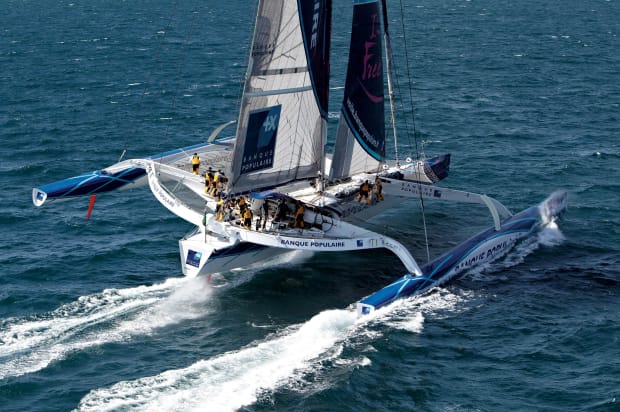
Photo courtesy of BPCE
“The fastest I have been,” he adds, “is 48 knots on Banque Populaire V. At over 50 knots of speed, I have read that you need a different type of foil. Perhaps there is a natural limit, like a supersonic water barrier. To break that barrier, you need to get to 45 knots in less and less wind to lift that weight out of the water. In the future, I can see offshore trimarans doing over 40 knots for longer periods of time.”
If and when the sailing world does get to this point, expect to see Brian Thompson boldly leading the way, where few if any sailors have ever gone before.
Ed Note: For the latest on Brian Thompson’s sailing exploits, visit brianthompsonsailing.com
July/August 2022








